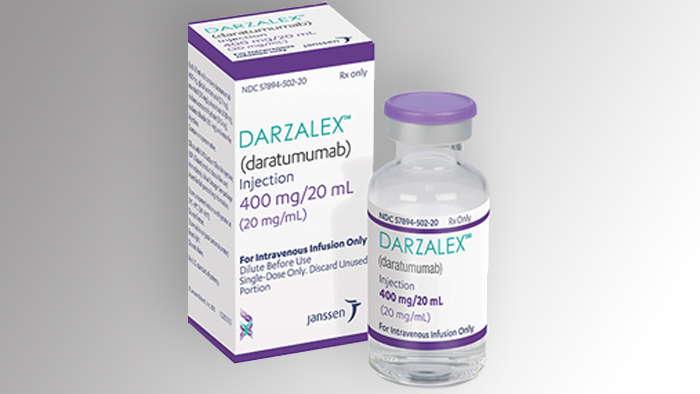Adding Darzalex (daratumumab) to standard regimens for adults with relapsed or refractory multiple myeloma resulted in higher rates of deep and durable responses, according to exploratory analyses of two Phase 3 trials.
These findings, from the ongoing POLLUX (NCT02076009) and CASTOR (NCT02136134) trials, were based on patients achieving and sustaining a status of minimal residual disease (MRD) negativity — less than one cancer cell per 100,000 white blood cells — which is associated with prolonged survival without signs of disease progression.
The data also support the value of using MRD negativity and sustained MRD to predict clinical outcomes in this patient population, the researchers noted.
The results were described in the study, “Evaluation of Sustained Minimal Residual Disease Negativity With Daratumumab-Combination Regimens in Relapsed and/or Refractory Multiple Myeloma: Analysis of POLLUX and CASTOR,” published in the Journal of Clinical Oncology.
Janssen’s Darzalex is an antibody that blocks the activity of a protein called CD38 on the surface of myeloma cells, promoting cancer cell death directly and triggering immune responses against these cells.
The approval of Darzalex, in combination with either Revlimid (lenalidomide) or Velcade (bortezomib) plus dexamethasone, for relapsed or refractory multiple myeloma patients were based on positive results from POLLUX and CASTOR.
Both trials evaluated whether adding Darzalex to standard treatment — Revlimid and dexamethasone in POLLUX, and Velcade and dexamethasone in CASTOR — was superior to standard treatment alone at delaying disease progression.
After a median follow-up of 1.5 years to more than two years, each Darzalex combo significantly reduced the risk of progression or death by more than 59% and led to more than fourfold higher rates of MRD negativity, when compared with the corresponding standard treatment.
MRD negativity is a more stringent definition of complete response (disease eradication), meaning that patients show no evidence of the small number of cancer cells that sometimes remain after treatment and are missed with common lab exams.
Previous studies have shown that MRD negativity is a better predictor of survival and progression-free survival (PFS) than the presence of a complete response in people with newly diagnosed multiple myeloma. PFS is the time a patient lives until disease progression or death.
However, the predictive value of MRD negativity in relapsed or refractory multiple myeloma remains undetermined.
An international team of researchers, including those at Janssen, have now evaluated whether MRD-negative status and sustained MRD negativity may serve as a predictive measure of PFS by analyzing four years of data from POLLUX and CASTOR.
These studies contain the largest set of MRD data prospectively collected among relapsed or refractory myeloma patients. A total of 596 patients in POLLUX and 498 in CASTOR were randomly assigned to receive either a Darzalex combo or standard treatment (control group). All participants had received at least one prior therapy.
Results showed both Darzalex combos resulted in four times higher MRD negativity rates, compared with standard regimens (32.5% vs. 6.7% in POLLUX, and 15.1% vs. 1.6% in CASTOR).
Also, a higher proportion of Darzalex-treated patients remained MRD-negative for at least six months (20.3% vs. 2.1% in POLLUX, and 10.4% vs. 1.2% in CASTOR) and 12 months (16.1% vs. 1.4% in POLLUX, and 6.8% vs. 0% in CASTOR).
Notably, regardless of treatment, patients achieving MRD negativity had a lower risk of disease progression or death, and sustained MRD negativity was associated with prolonged PFS.
Similarly, a combined analysis of POLLUX and CASTOR data showed that patients achieving complete response or better and MRD negativity had prolonged PFS than those who did not, regardless of therapy regimen.
These findings supported the predictive value of MRD-negative status and sustained MRD negativity in this patient population.
“Achieving durable MRD negativity may predict long-term outcomes, as durable MRD negativity improves PFS and increases the time between treatment relapses for [relapsed or refractory multiple myeloma],” the researchers wrote.
However, both MRD-negative and MRD-positive patients in the Darzalex groups lived longer without signs of disease progression than those in the control groups.
In addition, a higher proportion of Darzalex-treated patients achieved “deep and sustained MRD-negative responses, resulting in longer periods without disease progression,” the team wrote.
“[Darzalex]-based combinations induce higher rates of sustained MRD negativity versus standard of care, which are associated with durable remissions and prolonged clinical outcomes,” the researchers concluded.
The post Darzalex Combos Linked to Stronger Cancer Eradication, Prolonged Survival appeared first on Myeloma Research News.

